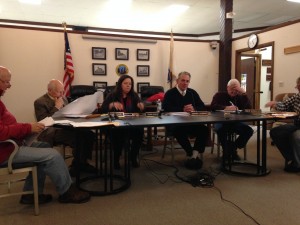The draft zoning bylaws that address formula businesses and the dimensional use of land in Marion inched closer toward appearing on the Town Meeting warrant when (most) members of the Marion Planning Board voted February 17 to accept the proposed draft bylaws, subject to town counsel review.
There were some dissenting remarks and comments from board member Norman Hills, who voted to oppose the dimensional use bylaw in a 4-1 vote because, among other things, he found much of the dimensional requirements table to be arbitrary and unjustifiable.
The table proposed a 40 percent maximum lot coverage and 60 percent minimum green space coverage for all four residential zones, with most business zones reflecting different lot coverage to green space ratios.
“What is it we’re trying to solve by this, because it’s not clear to me what we’re doing,” said Hills. “The maximum lot coverage (numbers) … I don’t know what the justification is for them.”
Planning Board member, and Bylaw Subcommittee member, Robert Lane said by limiting the green space coverage, in essence, the board automatically limits the building size. Board member and subcommittee member Rico Ferrari said this gives the designer “guidelines to go by” during the planning process.
“It’s kind of up to him,” said Ferrari, “…instead of us saying we don’t want a 14,000 square-foot building.”
The bylaw’s definition of maximum lot coverage includes aspects such as parking lots, walkways, porches, and awnings as ‘impervious surfaces,’ which prompted board member Steven Gonsalves to say that ‘impervious’ is “always a head scratcher” for him.
What about shells? What about a deck constructed of planks built above crushed bluestone?
“You probably just identified some gray area right there,” said Chairman Stephen Kokkins.
Hills added that one could make an entire parking lot pervious, pointing out that, as a board, members have never tackled the pervious versus impervious issue.
After further discussion, Hills’ argument over the dimensional use table resulted in a shift from 60-40 to 50-50 maximum lot coverage/minimum green space.
Hills still had further remarks, questioning the inclusion of a certain footnote below the table advising that one could seek a special permit or variance from the Zoning Board of Appeals to shift the dimensions for limited business, general business, marine business, and limited industrial zones to 80 percent maximum lot coverage and 20 percent minimum green space.
Hills said it appeared as though the bylaw was saying, “You don’t like what we’re telling you, you can come back and ask for 80 percent.”
“Variances are very tough to obtain,” said Kokkins.
Nonetheless, the validity of the footnote remained in question and was eventually removed from the bylaw.
Hills was concerned that one public hearing to vet the bylaws before Town Meeting was not enough, but other board members agreed to wait and watch what happens at the public hearing and go from there, agreeing that, regardless of whether the bylaws move forward, the board as a whole would not endorse the citizen’s petition formula bylaw submitted by former Planning Board member Ted North.
Also during the meeting, the board granted an Approval Not Required for Dennis and Karen Clemshaw of 99 Perry’s Lane.
The application requested the removal of two lot lines of a property that straddles the Rochester/Marion town line, but will withhold the plans signed by the board until the applicant’s representative, Kevin Frogue of G.A.F. Engineering, can provide the board with a letter from the Town of Rochester accepting its responsibility to provide the residence, under construction, with emergency response services.
Before adjourning, there was more controversy during the acceptance of the meeting minutes, with Hills again adamantly opposing the board’s prior motion to condense meeting minutes, distilling them down to basic details such as members and others in attendance and motions made, excluding verbatim quotes and conversation from the record.
“I still think these minutes are a disservice to the Town and an abdication of our responsibility to the Town,” said Hills.
In response, Gonsalves cried, “Hear, hear!”
Kokkins reminded Hills that community television video recordings and employee voice recordings were still available for submission with the minutes. Hills challenged anyone on the board to show him where in the law it states DVDs and recordings are a substitute for meeting minutes.
“They do not substitute for the minutes of this meeting,” said Hills, before opposing the acceptance of the minutes in another 4-1 vote.
The next meeting of the Marion Planning Board is scheduled for March 2 at 7:00 pm at the Marion Town House.
By Jean Perry
